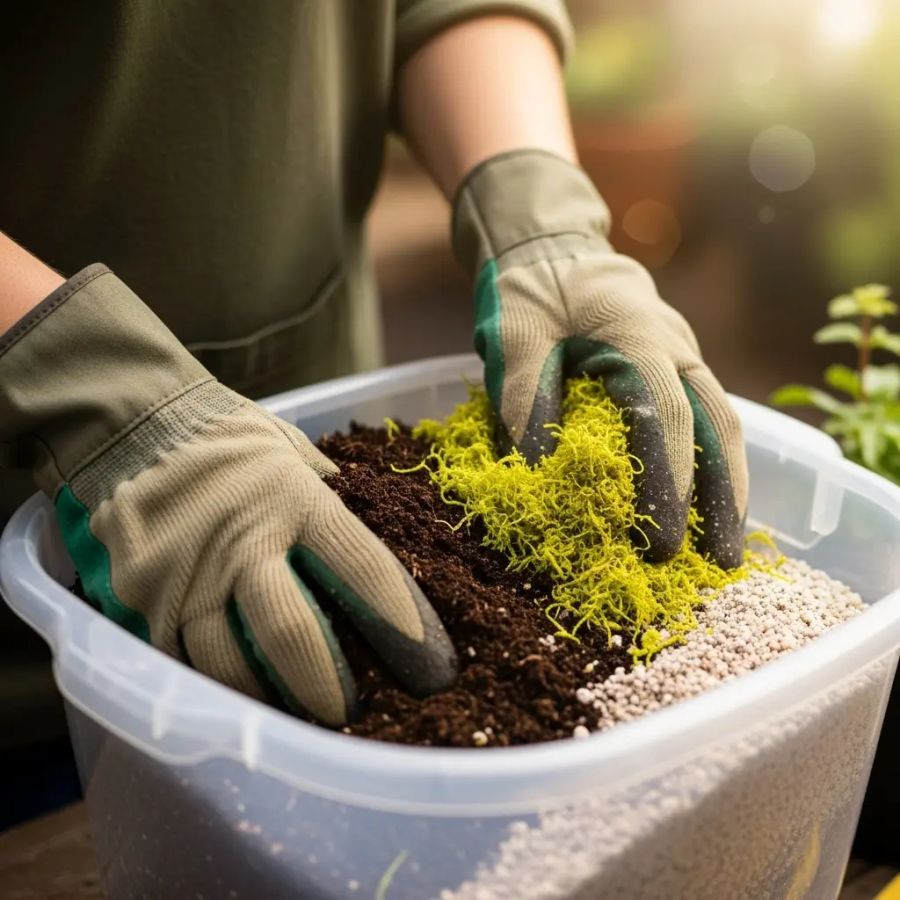Bags of potting mix are expensive. If you have a lot of containers, the cost adds up fast.
You can make your own potting mix. It is cheaper than buying it. And you control exactly what goes into it. This means you can create a better environment for your plants. The trend of creating custom soil blends is growing in 2025, as gardeners want more control over inputs and want to reduce waste.
Why Make Your Own Potting Mix?
Making your own mix has two main benefits: it costs less and you know what's in it.
It Saves You Money
Buying the main ingredients in bulk is cheaper than buying small, pre-made bags. If you plan to fill more than a few pots for your container garden, mixing your own will save you money. The initial cost of the bulk ingredients is higher, but you get much more for your dollar.
You Control the Ingredients
Bagged mixes can contain low-quality fillers or synthetic fertilizers. When you make your own, you choose every component. You can use high-quality organic materials. You can also customize the mix for the specific needs of different plants, like tomatoes or succulents.
The Three Main Ingredients
A good potting mix provides three things: moisture retention, aeration, and nutrients. This simple recipe uses one ingredient for each job.
1. The Base: Coconut Coir or Peat Moss
This is the bulk of your mix. Its job is to hold water for the plant's roots.
- Coconut Coir: This is a byproduct of the coconut industry. It holds water well and has a neutral pH. It is a renewable resource.
- Peat Moss: This is the traditional base for potting mixes. It is acidic, which some plants like. There are environmental concerns about harvesting it.
2. Aeration: Perlite or Vermiculite
This ingredient keeps the mix from becoming a dense brick of mud. It creates air pockets so roots can breathe.
- Perlite: This is a volcanic glass that is heated until it pops like popcorn. It looks like small, white styrofoam balls. It adds excellent drainage and aeration but holds no water.
- Vermiculite: This is a mineral that also provides aeration. It holds some water and nutrients, unlike perlite.
3. Nutrients: Compost
This is the food for your plants. It provides a slow release of essential nutrients. Use a finished, high-quality compost. It should look and smell like rich, dark soil. Do not use unfinished compost, as it can harm your plants.
A Simple All-Purpose Potting Mix Recipe
This recipe is for a general-purpose mix that works well for most vegetables and flowers. It uses a 1:1:1 ratio, which is easy to remember. A "part" can be any container you choose, like a bucket or a shovel full.
The Recipe
- 1 part coconut coir or peat moss
- 1 part perlite
- 1 part compost
How to Mix It
- Get a large tarp or a wheelbarrow to mix on.
- Moisten the coconut coir or peat moss first. It can be dusty. A little water makes it easier to handle.
- Add the perlite and compost.
- Use a shovel or your hands to mix everything together until the color and texture are uniform.
Your potting mix is now ready to use. This balanced approach is key. As the Oregon State University Extension Service notes, "The ideal potting mix is not soil at all but a 'soilless' medium that provides an optimal balance of air, water, nutrients, and anchorage."
How to Customize Your Mix
You can adjust this basic recipe for different plants.
For Seed Starting
Seeds need a fine mix with fewer nutrients.
- 2 parts coconut coir or peat moss
- 1 part perlite
- 1/2 part compost
For Cacti and Succulents
These plants need excellent drainage to prevent root rot.
- 1 part compost
- 1 part coconut coir or peat moss
- 2 parts perlite or pumice
Frequently Asked Questions
Can I use dirt from my yard in my potting mix?
No. Garden soil is too heavy and dense for pots. It compacts quickly, smothers roots, and does not drain well. It can also contain pests and weed seeds. This is one of the most common gardening mistakes.
Is it really cheaper to make your own potting mix?
Yes, in most cases. While you have to buy larger bags of ingredients upfront, the cost per gallon of your homemade mix is much lower than pre-made bags, especially if you are filling many large containers for plants like tomatoes.
What's the difference between potting soil and potting mix?
The names are often used interchangeably, but there is a difference. "Potting soil" may contain actual mineral soil (sand, silt, clay). "Potting mix" is a soilless medium made from ingredients like peat moss, coir, perlite, and compost. Soilless mixes are better for containers.
How do I store leftover DIY potting mix?
Store it in a covered container, like a bucket with a lid or a sealed bag. This keeps it from getting waterlogged by rain and prevents pests from moving in. Keep it in a shed or garage.
Do I need to sterilize my homemade potting mix?
For most plants, no. If you use high-quality, bagged ingredients, they are generally clean. If you are starting delicate seeds or are concerned about pathogens in your compost, you can sterilize the mix by baking it in the oven, but it is usually not necessary.
Can I add anything else to my potting mix?
Yes. You can add things like worm castings for extra nutrients or biochar to improve water retention. The 1:1:1 recipe is a great starting point. You can experiment as you learn what your plants like.
